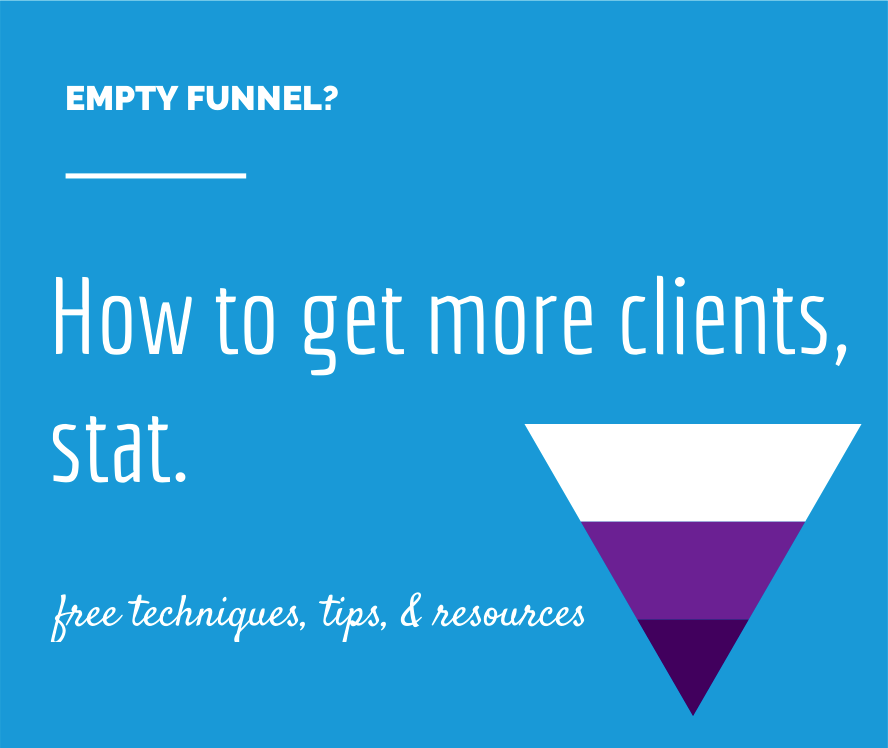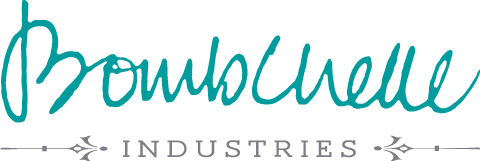
This article was inspired by a question in a Facebook group I’m in:
Anyone have awesome resources for gigs? I’m looking at dribbble, behance, coroflot and craigslist right now to fill the (very large) gap but it’s not happening. Any places you can point a designer with a mad open schedule would be really great!
I’m pretty familiar with this process, as I’ve been working on this (albeit sloooowly, over the last several weeks, with the knowledge that it usually takes a few weeks to gain traction and that I had a buffer) in anticipation of my transition back to full-time self-employment (which is complete next Monday!). After leaving a few comments on the thread that were windy even by my standards, I thought, yanno, I should just put this all in a blog post.
So, without further ado, here’s a list of ways to get more work ASAP – even when you currently don’t have any on the horizon.
1. Previous client follow up.
Email every single person that has bought something from you, worked from you in the past, or expressed interest in working with you in the past, and give them an update on what kind of packages are available from you at this time. You’d be surprised how often this will result in more work, especially if y’all had a really good rapport the first time around.
If you don’t already have client follow up systems in place, a good time to set them up is after you’re out of this immediate crunch. (Self-promotion: I have something that is perfectly intended to help with that.) You can actually start working on it now, if your time that isn’t spent pitching yourself isn’t already full with client work.
2. Make it easy for you to find gigs, and start pitching them.
Make it easy for you to find gigs.
You can automate a large part of this process using IFTTT (more on that below, under the resources section). Once it’s set up, you’ll no longer have to check the job boards or Craigslist once or twice a day – you’ll just automatically get an email when something new is posted and can move straight on to pitching.
Have a template on hand.
Obviously, you don’t want to send a form template that’s literally copied and pasted for every single gig. That’s easily spotted a mile off and is not likely to get you new work any time soon. But it’s a good idea to have a framework to work off of – something that you can use to speed up the process and add/subtract as needed. If you have a few different areas you work in (for example, print design and web design, social media marketing and writing), it’s a good idea to have a template for each specialty.
Here’s a rough template for you, based on what I use:
Hi [name]!
I saw your posting on [job board] and wanted to send in my information. You’ll find my resume attached and you can view my online portfolio here: [link, and if a specific page has sample work or case studies, link to those pages individually as well]
I’d be a great fit for this because…[Talk about your background here. Good structure is one sentence covering your overall background, one sentence that mentions your experience and if you have any specialties within that experience – B2B writing vs. health writing, for example, and one or two sentences that mention a specific project that’s relevant to this gig.]
Let me know if you have any questions. I’d be available for a phone/Skype call or to meet for coffee [obviously, take that out if this isn’t a local job] sometime in the next week if you wanted to discuss the role and my experience.
Thanks so much for your time and have a great day!
[your name]
Things of note:
- Make sure to look for a contact name and if there’s one in the post, use it.
- If they ask specific questions, answer them. Like I said, don’t just copy and paste your template mindlessly – tweak and refine.
- Don’t forget to thank them for their time – I’ve been the one reading job emails and it’s truly disconcerting how many just end rather abruptly.
Set goal metrics.
Depending on how busy I am currently and how quick of a turnaround time I’m working with, I’ll set a goal for pitching three or five gigs a day. Sometimes more. Having a set metric saves you from aimlessly wandering about trying to decide what to send in your info for and what to pass on.
Do five a day, first thing in the morning, boom done, move on to working on your other work for the day. (I’d suggest doing something that will bring clients to you in the longer term, if your day is empty of client work – guest posting, creating videos or blog posts, webinars, etc.)
3. Look at agencies and talent networks
Agencies are often looking for freelancers, short-term or long-term. There are many advantages from an agency POV to hiring a freelancer instead of a full time employee – so get on that, and also look at talent networks. (See specific links in the resources section, below.)
Also worth looking at: see if your city has Facebook, Google+, or LinkedIn groups meant for freelancers or job-hunters. For Austin, there’s Austin Digital Jobs and Austin Freelance Gigs, and probably other ones I’m not aware of – but just engaging in those two groups alone has been incredibly useful.
4. Reach out to friends & colleagues
You’d be surprised where client work can come from. With that in mind, email friends you know that exist in the business world, post on your personal Facebook page, and so on, just letting people know you have availability and reminding them of who you are and what you do.
In the same vein, but slightly less scattershot, email everyone you know that works in a complementary field. (If we’re sticking with the designer example, reach out to copywriters, developers…and so on.) Tell them that you’re looking to get to know more people whose work complements your’s, so that you can refer people to them. Ask them what their specialty is and who you should send to them. Most people will reciprocate and the good karma makes up for the ones who don’t.
5. Do a time or number limited promotion to fill the gap
I am definitely not suggesting that you discount your services. If you have products, doing a sale can help out in a time of tight-cash-flow, but discounting services often just leads to more stress and a feeling of resentment.
Instead, you can capitalize on something timely. Example: you’re a designer and you’re itching for some new clients. Twitter just unveiled those pain in the ass new cover images and larger profile pictures. Facebook is rolling out something similar soon, too. Offer ten Twitter packages that go with the new layout. The idea is to give people something they can latch on to. “Design services” is not as concrete as “$X for a Twitter layout that doesn’t make you feel outdated and inadequate.” (I may or may not have some baggage about the new Twitter layout, can you tell?)
Not that “design services” are bad at all – but when you’re in a crunch like this, you want to give people as much incentive as possible to act NOW. Huge networking conference coming up in your city? Do a LinkedIn profile writing package. You get the idea – come up with two or three options, get feedback on them, and move forward with the one that’s going to be the easiest sell for you, your skills & talents, and your audience.
The resource list:
Agencies and/or talent networks that hire remote workers and/or are nationwide:
This is by no means exhaustive, but it’s a place to start, at least:
Aquent
Razorfish
VitaminTalent
CreativeCircle
Also, check out temp agencies near you – they’re often looking for short-term designers, coders, writers, etc. Some of these places will have full time jobs, some will have part time or freelance positions, but they’re all worth checking out.
Job boards and the like:
Marketplaces:
You’ve probably heard of most of these, but in case you haven’t:
Elance
Guru
oDesk
PeoplePerHour
Job boards or aggregators of job listings:
Smashing Magazine (mostly design and development)
Envato Studio (ditto)
BloggingPro (shock: blogging focused)
ProBlogger job board (…ditto)
MediaBistro (this is the link to the freelance section of their board; mostly journalism, writing, or PR related)
Freelance Writing Gigs (collects writing gigs from across the web and sends them out daily; can be useful although getting to the listing before it’s posted here – which is where IFTTT comes in – is ideal, because after it’s posted here there’s usually a deluge of applicants)
WeWorkRemotely (collects remote work jobs from across the web, some full-time employees, some freelance)
Flexjobs (Similar to WeWorkRemotely, except it costs money; I’ve found some good opportunities through here, but none have come to fruition yet.)
AuthenticJobs (similar to WeWorkRemotely and Flexjobs in that it’s a mix of freelance and employment opportunities)
IFTTT: Set up an RSS feed -> email trigger for each of the job boards above, and set up a new Craigslist search result -> email trigger for words associated with the kind of work you’re looking for – both in the jobs AND gigs section. Here’s a quick how to video:
And of course, make sure this doesn’t happen again in the future:
Get the new & improved Client Follow Up Action Kit and use it to follow up with past clients. That way, you know this isn’t going to happen again in six months – consistent follow up, not only with prospects and people you’ve talked to in the past, but with previous clients, will definitely help (and can entirely eliminate, in some cases, especially if combined with a solid marketing strategy) dry spells.
